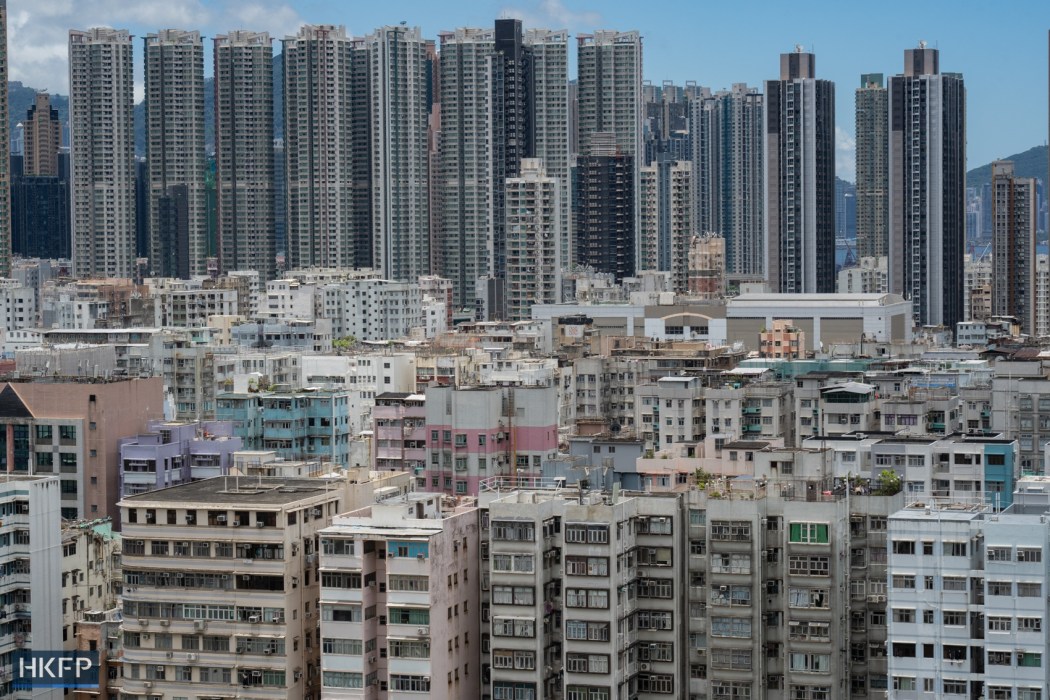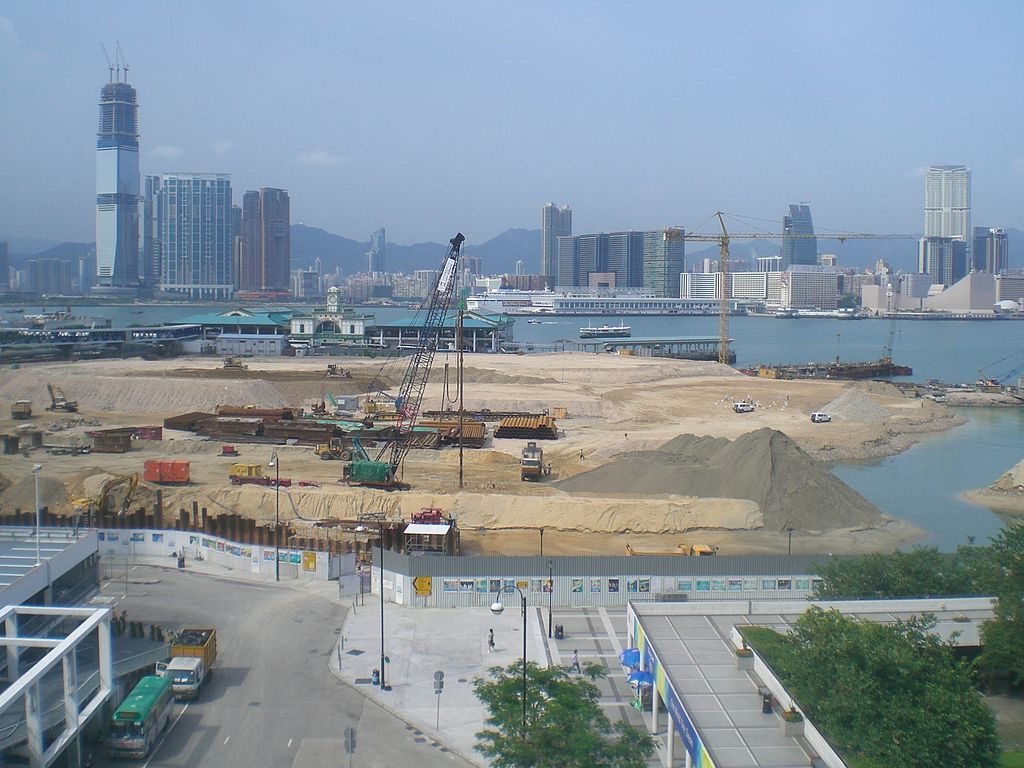Hong Kong’s wealthier districts will warm at a slower rate than its poorest areas, a recent research paper has found, leaving those living in low-income neighbourhoods at greater risk of exposure to heat considered dangerous to human survival.

Postdoctoral fellow at the University of Hong Kong, biological scientist Michael Boyle, explored the relationship between the median monthly salary of Hong Kong districts and their climate conditions. By dividing the city into 30 metre by 30 metre squares, and taking temperature and humidity data for each of those squares, Boyle was able to map climate conditions for every constituency in Hong Kong.
“This facilitated making climate predictions for each individual voting ward,” Boyle, who is currently in the UK, told HKFP by email on Tuesday.
He found that areas with the lowest median monthly incomes of HK$11,000 to HK$12,000 – among them parts of Kowloon City, Sham Shui Po, Kwai Tsing, North District and Yuen Long – already experienced wet-bulb temperatures of up to 31.3 degrees Celsius.
Wet-bulb temperatures combine temperature and humidity to evaluate how well humans can cool themselves by sweating. A wet-bulb temperature of 35 degrees is the threshold beyond which the human body is unable to cool itself through perspiration, representing what Boyle calls in his paper “a physiological limit to human survival.”

The ambient temperature must reach 36.3 degrees at a relative humidity of 85 per cent, which is common in Hong Kong, to reach a wet-bulb temperature of 35 degrees.
“Projecting into the future using global climate change models, the wealthiest districts will have roughly 30 years longer than less wealthy districts before temperatures that are considered dangerous to human survival are reached,” Boyle said by email.
“Based on my findings, combinations of temperature and humidity considered dangerous to human survival may be experienced in Hong Kong as a normal part of the climate by the end of the century.”
Hong Kong recently recorded its hottest summer since records began in 1884, and was subsequently pummelled by Super Typhoon Saola and record-breaking rainfall early this month. Climate experts have warned that extreme weather events, including extreme heat, will become more frequent going forward.

Boyle modelled three climate warming scenarios, ranging from least to most severe, to see how long it may take for wet-bulb temperatures to become an expected feature of Hong Kong’s summers. “This is different to a heat wave or random very hot days, which could occur much earlier,” he told HKFP.
According to the most severe predictions, wet-bulb temperatures of 35 degrees Celsius could be commonplace in Hong Kong by the end of this century. Based on the least severe scenario, it would take until around 2180 to reach the same threshold.
“Regardless of warming rate, the wealthiest districts would have at least another 25-30 years of thermal safety before experiencing the same harmful temperatures as less wealthy districts,” the paper, which had been accepted for publication by the journal Environmental Research Letters, read.
Future proofing
Areas within the government’s Northern Metropolis development plan, which would see the creation of a “work-live-play” central business district near Hong Kong’s border with mainland China, were identified in Boyle’s paper as among those most vulnerable to extreme heat in the future.

By contrast, he noted that the proposed Kau Yi Chau Artificial Islands project would “likely be preferable” from a climate perspective “as they will be buffered from extreme temperatures for many decades in comparison to more continental northern regions.” However, Boyle did say that such reclamation projects came with “their own suite of environmental and economic issues.”
Responding to enquiries from HKFP, the Development Bureau said the Northern Metropolis would be built “with modern urban design and resilient infrastructure, allowing future population to better adapt to climate change.”

The bureau said that the planned tech hub within the area, the San Tin Technopole, would be planned according to the 15-minute city concept, “where residents’ needs can be mostly catered for within a 15-minute walk,” thus reducing “greenhouse gas emissions that contribute to climate change.”
Open space would also be incorporated, “providing plenty of space for tree planting, thereby helping moderate temperature,” the bureau added.
See also: What is Hong Kong’s San Tin Technopole and why is the planned tech hub controversial?
Mee Kam Ng, director of the Urban Studies at the Chinese University of Hong Kong, told HKFP that it was essential to work with nature when building climate-proofed cities to mitigate the impacts of the climate crisis on residents.
“We have to try our best to have an ecosystem restoration mindset in our planning and development process. The natural conditions should always be the first thing that we consider when we initiate planning and development,” she said.

Climate advocate and urban planner Chin Chin Lam said that when it came to Hong Kong’s poorest areas, urban renewal may be the answer to enhancing climate resilience.
“Because a lot of the poorest neighbourhoods in Hong Kong are also the oldest and the most high density,” she told HKFP by phone. “That includes Sham Shui Po, Kwun Tong, To Kwa Wan.”
To help cool these areas, Lam suggested “active greening and implementing water features… not only a park, but a nullah, a river, these are also important elements on top of urban renewal.”
According to Ng, it was essential to adopt a localised approach. “Climate-proofing a city is the best way to protect everyone… Planners should plan with the context and not apply hard standards disregarding the actual situations on the ground,” Ng said.
Boyle, whose research found that tree coverage had less impact on lowering wet-bulb temperatures in Hong Kong than expected, agreed. “Tropical and subtropical cities have their own set of conditions that mean there is not a ‘one-size fits all; approach to mitigating urban temperatures globally,” he said by email.

He said the question of how to make Hong Kong cooler was “a difficult one,” but said he expected Hongkongers to adapt their behaviour, with public indoor spaces like malls being used by those who cannot afford to run their air conditioning through extreme heat.
In some low-income areas, Lam said at-risk residents were already seeking refuge from extreme heat in fast food restaurants such as McDonald’s or Fairwood, “because they can’t afford air-con.”
“We need more heat shelters or just normal spaces for people to freely, without paying money, to take rest… that is something that the government should provide for poorer or older neighbourhoods,” Lam said, adding that they needed to be easily accessible for elderly residents with less mobility.
Last year, Lam lobbied Sham Shui Po District Council, the Home and Youth Affairs Bureau and the Hong Kong Observatory to ask for the implementation of a system that would measure the microclimate of high-risk neighbourhoods.
“They feel heat differently than other neighbourhoods, the local temperature in Sham Shui Po would be hotter than other places,” Lam said, meaning that it may need temporary heat shelters even if the rest of the city did not. “Under the current system, it’s a one-city fits all,” she said.
The Observatory responded to Lam’s request and said they would explore having more heat measurements to better reflect the actual conditions in the city.
Another “big issue” identified by Lam and Boyle was those who work outdoors, and who were at greater risk of exposure to extreme heat.
“They are also more likely to live in less affluent areas where the temperature is already higher,” Boyle said. “There needs to be a stronger legislation to protect these people from harmful conditions in their workplaces.”
Support HKFP | Policies & Ethics | Error/typo? | Contact Us | Newsletter | Transparency & Annual Report | Apps
Help safeguard press freedom & keep HKFP free for all readers by supporting our team

LATEST FROM HKFP
HKFP has an impartial stance, transparent funding, and balanced coverage guided by an Ethics Code and Corrections Policy.
Support press freedom & help us surpass 1,000 monthly Patrons: 100% independent, governed by an ethics code & not-for-profit.










